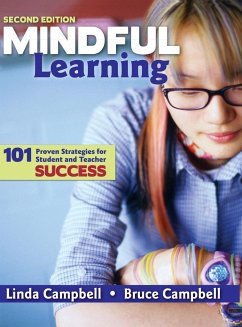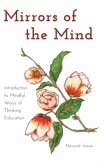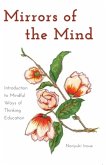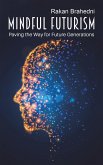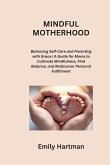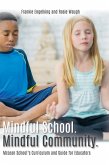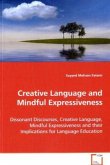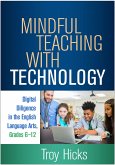- Gebundenes Buch
- Merkliste
- Auf die Merkliste
- Bewerten Bewerten
- Teilen
- Produkt teilen
- Produkterinnerung
- Produkterinnerung
With new forms, techniques, and checklists, this second edition provides 101 strategies for using learners' prior knowledge.
Andere Kunden interessierten sich auch für
![Mirrors of the Mind Mirrors of the Mind]() Norijuki InoueMirrors of the Mind147,80 €
Norijuki InoueMirrors of the Mind147,80 €![Mirrors of the Mind Mirrors of the Mind]() Norijuki InoueMirrors of the Mind41,85 €
Norijuki InoueMirrors of the Mind41,85 €![Mindful Futurism Mindful Futurism]() Rakan BrahedniMindful Futurism10,99 €
Rakan BrahedniMindful Futurism10,99 €![MINDFUL MOTHERHOOD MINDFUL MOTHERHOOD]() Emily HartmanMINDFUL MOTHERHOOD24,99 €
Emily HartmanMINDFUL MOTHERHOOD24,99 €![Mindful School. Mindful Community. Mindful School. Mindful Community.]() Frankie EngelkingMindful School. Mindful Community.48,99 €
Frankie EngelkingMindful School. Mindful Community.48,99 €![Creative Language and Mindful Expressiveness Creative Language and Mindful Expressiveness]() Ph.D. SayyedMohsen FatemiCreative Language and Mindful Expressiveness56,99 €
Ph.D. SayyedMohsen FatemiCreative Language and Mindful Expressiveness56,99 €![Mindful Teaching with Technology Mindful Teaching with Technology]() Troy HicksMindful Teaching with Technology62,99 €
Troy HicksMindful Teaching with Technology62,99 €-
-
-
With new forms, techniques, and checklists, this second edition provides 101 strategies for using learners' prior knowledge.
Hinweis: Dieser Artikel kann nur an eine deutsche Lieferadresse ausgeliefert werden.
Hinweis: Dieser Artikel kann nur an eine deutsche Lieferadresse ausgeliefert werden.
Produktdetails
- Produktdetails
- Verlag: Corwin
- 2. Auflage
- Seitenzahl: 214
- Erscheinungstermin: 5. September 2008
- Englisch
- Abmessung: 286mm x 221mm x 16mm
- Gewicht: 811g
- ISBN-13: 9781412966924
- ISBN-10: 1412966922
- Artikelnr.: 24665919
- Herstellerkennzeichnung
- Libri GmbH
- Europaallee 1
- 36244 Bad Hersfeld
- gpsr@libri.de
- Verlag: Corwin
- 2. Auflage
- Seitenzahl: 214
- Erscheinungstermin: 5. September 2008
- Englisch
- Abmessung: 286mm x 221mm x 16mm
- Gewicht: 811g
- ISBN-13: 9781412966924
- ISBN-10: 1412966922
- Artikelnr.: 24665919
- Herstellerkennzeichnung
- Libri GmbH
- Europaallee 1
- 36244 Bad Hersfeld
- gpsr@libri.de
Linda Campbell has extensive experience at all levels of education, including as a former public school K-12 teacher and NEA school restructuring specialist, and currently as a professor of education at Antioch University Seattle. In addition to serving as the University's project director for the Gates Foundation Early College Initiative for Native Youth, she is a consultant and a presenter. She also works with schools to promote the retention and achievement of Native American youth.
Preface to the Second Edition
Acknowledgments
About the Authors
Introduction
1. Beginning With What Students Know: The Role of Prior Knowledge in
Learning
What Role Does Background Knowledge Play in Learning?
What Do Research Studies Show About Prior Knowledge?
#1: The Known and the Unknown
#2: Things I Know, Think I Know, Want to Know
#3: What I Know, Want to Know, and Learned
#4: Getting Organized Graphically
#5: Visual Sequencing
#6: Visualizing Cause and Effect
#7: Seeing Similarities and Differences
#8: The Whole Pie
#9: Speaking Categorically
#10: Commonly Shared Prior Experiences
#11: Charting a Colorful Course
#12: Asking the Right Questions
#13: Guided Anticipation
#14: Thinking Out Loud
#15: Using Prior Knowledge Before, During, and After a Lesson
#16: It's About the Words
#17: Word Diagramming
#18: Tracking Progress With Words
#19: Math Dilemmas
Suggestions for Further Information About Prior Knowledge
2. Active Learning: Differentiated Strategies for All Learners
What Do Research Studies Show About Active Learning?
Active Learning in the Classroom
#20: Give Me Five! An Active Learning Wheel for Teachers and Students
#21: A Collaborative and Active Learning Sequence
#22: A Day of Active Division
#23: Visually Introducing a Unit
#24: Structured Concepts
#25: Visual Report Writing
#26: Charting Skills: Estimation
#27: Visual Story Mapping
#28: Mass Media's Messages
#29: Active Listening
#30: Active Reading
#31: Textbooks Are Friends!
#32: Active Involvement Through Discussion
#33: It's Notable
#34: Thinking From A to V
#35: That's Debatable
#36: Jigsaw Cards and Puzzles
#37: I'm Game
#38: Musical Learning
#39: Narrative Pantomime
#40: Role-Playing to Learn
#41: A Week's Worth of Journaling
#42: Student Goal Setting
#43: Project-Based Learning
#44: Pulling It Together: Class Books
Suggestions for Further Information About Active Learning
3. Ensuring Gender-Fair Instruction
What Do Research Studies Show About Gender-Equitable Approaches to
Improving Student Achievement?
#45: Conducting a Classroom Gender Audit
#46: Seeking Student Feedback on Gender Dynamics
#47: Assessing Bias in Curricular Materials
#48: Quality Questioning
#49: Using Inclusive Language
#50: Thinking While Listening
#51: Mix and Match
#52: Playing Games
#53: Sequence Cards
#54: Paper Plate Review
#55: Headbands
#56: A Word Tool Kit
#57: Bite-Size Reading
#58: Teaching Boys to Write
#59: Six Tips for Tech-Savvy Girls
#60: Creating a "Boy-Friendly" Classroom
#61: Exploring New Roles at School
#62: Peer Support Networks
#63: Orienting Eighth and Ninth Graders to High School
#64: Middle School Academic Preparation for High School Success
#65: Gender Equity Bookmark
Suggestions for Further Information About Gender Equity
4. Teaching Diverse Students: Addressing Language, Class, Culture, and
Ability Differences in the Classroom
The Diversity of the U.S. Educational System
The Diversity of K-12 Students in the United States
Defining Racial Diversity
Defining the Concept of Students With Disabilities
Defining Students in Poverty
Defining Limited English Proficient Students
Implications of Student Diversity for the Classroom
Teaching Students With Special Needs in Mainstream Classrooms
Integrating Limited English Proficient Students Into Mainstream Classrooms
Teaching Racially Diverse Students
Teaching Students in Poverty
Reflecting on Teaching in Diverse Classrooms
#66: Tiered Instruction
#67: Tiered Spelling
#68: Do They Get It? Assessing Student Understanding in Inclusive
Classrooms
#69: Teaching Elementary Readers
#70: Helping Struggling Intermediate Readers
#71: Teaching Reading in the Content Areas
#72: Helping Struggling Adolescent Readers
#73: Using Tutors to Increase Reading Achievement
#74: An Extra Net: Using Web Sites to Support the Needs of Diverse Learners
#75: Engaging the Gifted
#76: Helping New and Incoming Students
#77: Meeting the Needs of Preliterate English Language Learner Students
#78: Using English Effectively With English Language Learners
#79: Geometric Collaboration
#80: Collaborative Note Taking
#81: Teaching Standard English in the Multicultural Classroom
#82: High-Performing Teachers of High-Poverty Students
#83: Reducing Prejudice by Increasing Critical Thinking
#84: Multicultural Math
#85: Multicultural Literature
Suggestions for Further Information About Teaching Diverse Students
5. Assessing Student Performance
Defining Assessment Terms
What Does the Research Say About Using Assessment to Improve Teaching and
Learning?
The Power of Performance Assessment
Using Performance Assessment in the Classroom
#86: It¿s Not Business as Usual: Planning for Assessment
#87: Beginning With the End in Mind
#88: Taking Stock: Student Self-Assessment
#89: Collaborative-Assessment Conferences
#90: Test-Taking Matters
#91: Test-Taking Rules for Students
#92: Getting to Know You: Entry Interviews
#93: Saying Goodbye: Exit Interviews
#94: Taking Note With Anecdotal Records
#95: Making Rubrics
#96: Assessing Orally
#97: Observation Logs
#98: Checking Their Lists: Student Checklists
#99: Learning Logs
#100: Assessing Nontraditional Results
#101: Scheduling Assessment
Suggestions for Further Information About Assessing Student Performance
6. Some Concluding Thoughts
References
Index
Acknowledgments
About the Authors
Introduction
1. Beginning With What Students Know: The Role of Prior Knowledge in
Learning
What Role Does Background Knowledge Play in Learning?
What Do Research Studies Show About Prior Knowledge?
#1: The Known and the Unknown
#2: Things I Know, Think I Know, Want to Know
#3: What I Know, Want to Know, and Learned
#4: Getting Organized Graphically
#5: Visual Sequencing
#6: Visualizing Cause and Effect
#7: Seeing Similarities and Differences
#8: The Whole Pie
#9: Speaking Categorically
#10: Commonly Shared Prior Experiences
#11: Charting a Colorful Course
#12: Asking the Right Questions
#13: Guided Anticipation
#14: Thinking Out Loud
#15: Using Prior Knowledge Before, During, and After a Lesson
#16: It's About the Words
#17: Word Diagramming
#18: Tracking Progress With Words
#19: Math Dilemmas
Suggestions for Further Information About Prior Knowledge
2. Active Learning: Differentiated Strategies for All Learners
What Do Research Studies Show About Active Learning?
Active Learning in the Classroom
#20: Give Me Five! An Active Learning Wheel for Teachers and Students
#21: A Collaborative and Active Learning Sequence
#22: A Day of Active Division
#23: Visually Introducing a Unit
#24: Structured Concepts
#25: Visual Report Writing
#26: Charting Skills: Estimation
#27: Visual Story Mapping
#28: Mass Media's Messages
#29: Active Listening
#30: Active Reading
#31: Textbooks Are Friends!
#32: Active Involvement Through Discussion
#33: It's Notable
#34: Thinking From A to V
#35: That's Debatable
#36: Jigsaw Cards and Puzzles
#37: I'm Game
#38: Musical Learning
#39: Narrative Pantomime
#40: Role-Playing to Learn
#41: A Week's Worth of Journaling
#42: Student Goal Setting
#43: Project-Based Learning
#44: Pulling It Together: Class Books
Suggestions for Further Information About Active Learning
3. Ensuring Gender-Fair Instruction
What Do Research Studies Show About Gender-Equitable Approaches to
Improving Student Achievement?
#45: Conducting a Classroom Gender Audit
#46: Seeking Student Feedback on Gender Dynamics
#47: Assessing Bias in Curricular Materials
#48: Quality Questioning
#49: Using Inclusive Language
#50: Thinking While Listening
#51: Mix and Match
#52: Playing Games
#53: Sequence Cards
#54: Paper Plate Review
#55: Headbands
#56: A Word Tool Kit
#57: Bite-Size Reading
#58: Teaching Boys to Write
#59: Six Tips for Tech-Savvy Girls
#60: Creating a "Boy-Friendly" Classroom
#61: Exploring New Roles at School
#62: Peer Support Networks
#63: Orienting Eighth and Ninth Graders to High School
#64: Middle School Academic Preparation for High School Success
#65: Gender Equity Bookmark
Suggestions for Further Information About Gender Equity
4. Teaching Diverse Students: Addressing Language, Class, Culture, and
Ability Differences in the Classroom
The Diversity of the U.S. Educational System
The Diversity of K-12 Students in the United States
Defining Racial Diversity
Defining the Concept of Students With Disabilities
Defining Students in Poverty
Defining Limited English Proficient Students
Implications of Student Diversity for the Classroom
Teaching Students With Special Needs in Mainstream Classrooms
Integrating Limited English Proficient Students Into Mainstream Classrooms
Teaching Racially Diverse Students
Teaching Students in Poverty
Reflecting on Teaching in Diverse Classrooms
#66: Tiered Instruction
#67: Tiered Spelling
#68: Do They Get It? Assessing Student Understanding in Inclusive
Classrooms
#69: Teaching Elementary Readers
#70: Helping Struggling Intermediate Readers
#71: Teaching Reading in the Content Areas
#72: Helping Struggling Adolescent Readers
#73: Using Tutors to Increase Reading Achievement
#74: An Extra Net: Using Web Sites to Support the Needs of Diverse Learners
#75: Engaging the Gifted
#76: Helping New and Incoming Students
#77: Meeting the Needs of Preliterate English Language Learner Students
#78: Using English Effectively With English Language Learners
#79: Geometric Collaboration
#80: Collaborative Note Taking
#81: Teaching Standard English in the Multicultural Classroom
#82: High-Performing Teachers of High-Poverty Students
#83: Reducing Prejudice by Increasing Critical Thinking
#84: Multicultural Math
#85: Multicultural Literature
Suggestions for Further Information About Teaching Diverse Students
5. Assessing Student Performance
Defining Assessment Terms
What Does the Research Say About Using Assessment to Improve Teaching and
Learning?
The Power of Performance Assessment
Using Performance Assessment in the Classroom
#86: It¿s Not Business as Usual: Planning for Assessment
#87: Beginning With the End in Mind
#88: Taking Stock: Student Self-Assessment
#89: Collaborative-Assessment Conferences
#90: Test-Taking Matters
#91: Test-Taking Rules for Students
#92: Getting to Know You: Entry Interviews
#93: Saying Goodbye: Exit Interviews
#94: Taking Note With Anecdotal Records
#95: Making Rubrics
#96: Assessing Orally
#97: Observation Logs
#98: Checking Their Lists: Student Checklists
#99: Learning Logs
#100: Assessing Nontraditional Results
#101: Scheduling Assessment
Suggestions for Further Information About Assessing Student Performance
6. Some Concluding Thoughts
References
Index
Preface to the Second Edition
Acknowledgments
About the Authors
Introduction
1. Beginning With What Students Know: The Role of Prior Knowledge in
Learning
What Role Does Background Knowledge Play in Learning?
What Do Research Studies Show About Prior Knowledge?
#1: The Known and the Unknown
#2: Things I Know, Think I Know, Want to Know
#3: What I Know, Want to Know, and Learned
#4: Getting Organized Graphically
#5: Visual Sequencing
#6: Visualizing Cause and Effect
#7: Seeing Similarities and Differences
#8: The Whole Pie
#9: Speaking Categorically
#10: Commonly Shared Prior Experiences
#11: Charting a Colorful Course
#12: Asking the Right Questions
#13: Guided Anticipation
#14: Thinking Out Loud
#15: Using Prior Knowledge Before, During, and After a Lesson
#16: It's About the Words
#17: Word Diagramming
#18: Tracking Progress With Words
#19: Math Dilemmas
Suggestions for Further Information About Prior Knowledge
2. Active Learning: Differentiated Strategies for All Learners
What Do Research Studies Show About Active Learning?
Active Learning in the Classroom
#20: Give Me Five! An Active Learning Wheel for Teachers and Students
#21: A Collaborative and Active Learning Sequence
#22: A Day of Active Division
#23: Visually Introducing a Unit
#24: Structured Concepts
#25: Visual Report Writing
#26: Charting Skills: Estimation
#27: Visual Story Mapping
#28: Mass Media's Messages
#29: Active Listening
#30: Active Reading
#31: Textbooks Are Friends!
#32: Active Involvement Through Discussion
#33: It's Notable
#34: Thinking From A to V
#35: That's Debatable
#36: Jigsaw Cards and Puzzles
#37: I'm Game
#38: Musical Learning
#39: Narrative Pantomime
#40: Role-Playing to Learn
#41: A Week's Worth of Journaling
#42: Student Goal Setting
#43: Project-Based Learning
#44: Pulling It Together: Class Books
Suggestions for Further Information About Active Learning
3. Ensuring Gender-Fair Instruction
What Do Research Studies Show About Gender-Equitable Approaches to
Improving Student Achievement?
#45: Conducting a Classroom Gender Audit
#46: Seeking Student Feedback on Gender Dynamics
#47: Assessing Bias in Curricular Materials
#48: Quality Questioning
#49: Using Inclusive Language
#50: Thinking While Listening
#51: Mix and Match
#52: Playing Games
#53: Sequence Cards
#54: Paper Plate Review
#55: Headbands
#56: A Word Tool Kit
#57: Bite-Size Reading
#58: Teaching Boys to Write
#59: Six Tips for Tech-Savvy Girls
#60: Creating a "Boy-Friendly" Classroom
#61: Exploring New Roles at School
#62: Peer Support Networks
#63: Orienting Eighth and Ninth Graders to High School
#64: Middle School Academic Preparation for High School Success
#65: Gender Equity Bookmark
Suggestions for Further Information About Gender Equity
4. Teaching Diverse Students: Addressing Language, Class, Culture, and
Ability Differences in the Classroom
The Diversity of the U.S. Educational System
The Diversity of K-12 Students in the United States
Defining Racial Diversity
Defining the Concept of Students With Disabilities
Defining Students in Poverty
Defining Limited English Proficient Students
Implications of Student Diversity for the Classroom
Teaching Students With Special Needs in Mainstream Classrooms
Integrating Limited English Proficient Students Into Mainstream Classrooms
Teaching Racially Diverse Students
Teaching Students in Poverty
Reflecting on Teaching in Diverse Classrooms
#66: Tiered Instruction
#67: Tiered Spelling
#68: Do They Get It? Assessing Student Understanding in Inclusive
Classrooms
#69: Teaching Elementary Readers
#70: Helping Struggling Intermediate Readers
#71: Teaching Reading in the Content Areas
#72: Helping Struggling Adolescent Readers
#73: Using Tutors to Increase Reading Achievement
#74: An Extra Net: Using Web Sites to Support the Needs of Diverse Learners
#75: Engaging the Gifted
#76: Helping New and Incoming Students
#77: Meeting the Needs of Preliterate English Language Learner Students
#78: Using English Effectively With English Language Learners
#79: Geometric Collaboration
#80: Collaborative Note Taking
#81: Teaching Standard English in the Multicultural Classroom
#82: High-Performing Teachers of High-Poverty Students
#83: Reducing Prejudice by Increasing Critical Thinking
#84: Multicultural Math
#85: Multicultural Literature
Suggestions for Further Information About Teaching Diverse Students
5. Assessing Student Performance
Defining Assessment Terms
What Does the Research Say About Using Assessment to Improve Teaching and
Learning?
The Power of Performance Assessment
Using Performance Assessment in the Classroom
#86: It¿s Not Business as Usual: Planning for Assessment
#87: Beginning With the End in Mind
#88: Taking Stock: Student Self-Assessment
#89: Collaborative-Assessment Conferences
#90: Test-Taking Matters
#91: Test-Taking Rules for Students
#92: Getting to Know You: Entry Interviews
#93: Saying Goodbye: Exit Interviews
#94: Taking Note With Anecdotal Records
#95: Making Rubrics
#96: Assessing Orally
#97: Observation Logs
#98: Checking Their Lists: Student Checklists
#99: Learning Logs
#100: Assessing Nontraditional Results
#101: Scheduling Assessment
Suggestions for Further Information About Assessing Student Performance
6. Some Concluding Thoughts
References
Index
Acknowledgments
About the Authors
Introduction
1. Beginning With What Students Know: The Role of Prior Knowledge in
Learning
What Role Does Background Knowledge Play in Learning?
What Do Research Studies Show About Prior Knowledge?
#1: The Known and the Unknown
#2: Things I Know, Think I Know, Want to Know
#3: What I Know, Want to Know, and Learned
#4: Getting Organized Graphically
#5: Visual Sequencing
#6: Visualizing Cause and Effect
#7: Seeing Similarities and Differences
#8: The Whole Pie
#9: Speaking Categorically
#10: Commonly Shared Prior Experiences
#11: Charting a Colorful Course
#12: Asking the Right Questions
#13: Guided Anticipation
#14: Thinking Out Loud
#15: Using Prior Knowledge Before, During, and After a Lesson
#16: It's About the Words
#17: Word Diagramming
#18: Tracking Progress With Words
#19: Math Dilemmas
Suggestions for Further Information About Prior Knowledge
2. Active Learning: Differentiated Strategies for All Learners
What Do Research Studies Show About Active Learning?
Active Learning in the Classroom
#20: Give Me Five! An Active Learning Wheel for Teachers and Students
#21: A Collaborative and Active Learning Sequence
#22: A Day of Active Division
#23: Visually Introducing a Unit
#24: Structured Concepts
#25: Visual Report Writing
#26: Charting Skills: Estimation
#27: Visual Story Mapping
#28: Mass Media's Messages
#29: Active Listening
#30: Active Reading
#31: Textbooks Are Friends!
#32: Active Involvement Through Discussion
#33: It's Notable
#34: Thinking From A to V
#35: That's Debatable
#36: Jigsaw Cards and Puzzles
#37: I'm Game
#38: Musical Learning
#39: Narrative Pantomime
#40: Role-Playing to Learn
#41: A Week's Worth of Journaling
#42: Student Goal Setting
#43: Project-Based Learning
#44: Pulling It Together: Class Books
Suggestions for Further Information About Active Learning
3. Ensuring Gender-Fair Instruction
What Do Research Studies Show About Gender-Equitable Approaches to
Improving Student Achievement?
#45: Conducting a Classroom Gender Audit
#46: Seeking Student Feedback on Gender Dynamics
#47: Assessing Bias in Curricular Materials
#48: Quality Questioning
#49: Using Inclusive Language
#50: Thinking While Listening
#51: Mix and Match
#52: Playing Games
#53: Sequence Cards
#54: Paper Plate Review
#55: Headbands
#56: A Word Tool Kit
#57: Bite-Size Reading
#58: Teaching Boys to Write
#59: Six Tips for Tech-Savvy Girls
#60: Creating a "Boy-Friendly" Classroom
#61: Exploring New Roles at School
#62: Peer Support Networks
#63: Orienting Eighth and Ninth Graders to High School
#64: Middle School Academic Preparation for High School Success
#65: Gender Equity Bookmark
Suggestions for Further Information About Gender Equity
4. Teaching Diverse Students: Addressing Language, Class, Culture, and
Ability Differences in the Classroom
The Diversity of the U.S. Educational System
The Diversity of K-12 Students in the United States
Defining Racial Diversity
Defining the Concept of Students With Disabilities
Defining Students in Poverty
Defining Limited English Proficient Students
Implications of Student Diversity for the Classroom
Teaching Students With Special Needs in Mainstream Classrooms
Integrating Limited English Proficient Students Into Mainstream Classrooms
Teaching Racially Diverse Students
Teaching Students in Poverty
Reflecting on Teaching in Diverse Classrooms
#66: Tiered Instruction
#67: Tiered Spelling
#68: Do They Get It? Assessing Student Understanding in Inclusive
Classrooms
#69: Teaching Elementary Readers
#70: Helping Struggling Intermediate Readers
#71: Teaching Reading in the Content Areas
#72: Helping Struggling Adolescent Readers
#73: Using Tutors to Increase Reading Achievement
#74: An Extra Net: Using Web Sites to Support the Needs of Diverse Learners
#75: Engaging the Gifted
#76: Helping New and Incoming Students
#77: Meeting the Needs of Preliterate English Language Learner Students
#78: Using English Effectively With English Language Learners
#79: Geometric Collaboration
#80: Collaborative Note Taking
#81: Teaching Standard English in the Multicultural Classroom
#82: High-Performing Teachers of High-Poverty Students
#83: Reducing Prejudice by Increasing Critical Thinking
#84: Multicultural Math
#85: Multicultural Literature
Suggestions for Further Information About Teaching Diverse Students
5. Assessing Student Performance
Defining Assessment Terms
What Does the Research Say About Using Assessment to Improve Teaching and
Learning?
The Power of Performance Assessment
Using Performance Assessment in the Classroom
#86: It¿s Not Business as Usual: Planning for Assessment
#87: Beginning With the End in Mind
#88: Taking Stock: Student Self-Assessment
#89: Collaborative-Assessment Conferences
#90: Test-Taking Matters
#91: Test-Taking Rules for Students
#92: Getting to Know You: Entry Interviews
#93: Saying Goodbye: Exit Interviews
#94: Taking Note With Anecdotal Records
#95: Making Rubrics
#96: Assessing Orally
#97: Observation Logs
#98: Checking Their Lists: Student Checklists
#99: Learning Logs
#100: Assessing Nontraditional Results
#101: Scheduling Assessment
Suggestions for Further Information About Assessing Student Performance
6. Some Concluding Thoughts
References
Index

